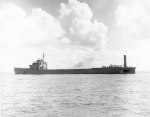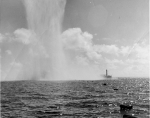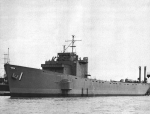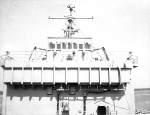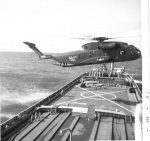Pierside at American Shipbuilding, Lorraine, Ohio, in April 1969
U.S. Navy photo and article from the April 1971 edition of All Hands magazineMINESWEEPER SPECIAL
"THE WORLD'S LARGEST OUTBOARD"A research and development project undertaken in the Atlantic Fleet Mine Force was centered on tests of the Minesweeper Special (MSS-1), a virtually unsinkable ship which literally would have to be blown to bits before it could be sunk. MineLant tested the ship, officially considered a "device," in search of an unsinkable ship capable of sweeping influence mines. Tests to date have been encouraging. Traditionally, minesweepers are built with wooden hulls to present the smallest possible magnetic signature. Steaming through a suspected mined area, the ordinary sweeper trails sound and magnetic equipment which detonates mines at a safe distance behind the ship. The Minesweeper Special takes a different approach. Built on a converted World War II Liberty class hull, the MSS-1 measures some 440 feet long and 57 feet wide and displaces nearly 15,000 tons. She is "unsinkable" because she is filled with about 140,000 cubic feet of styrofoam. All compartments below the waterline are flooded for additional ballast. According to Lieutenant Eugene N. Cate, officer in charge of the ship, this arrangement means that shock waves from nearby explosions "pass through" the steel hull. Naturally, the steel hull of the old Liberty ship presents a large magnetic signature and this is the whole idea. The main deck is also ringed with huge magnetic coils to enhance the ship's magnetic field, and there is equipment on board which produces noise in all frequencies. "The theory is to take our unsinkable ship into mined areas and purposely use it to detonate influence mines by presenting the maximum ship signature," LT Cate said. During shock tests in the Gulf of Mexico, LT Cate and the eight MSS-1 crewmembers took several teeth rattling explosions in the relative safety of the craft's
shock-mounted pilothouse. "In all tests we were strapped into padded chairs in the pilothouse," the o-in-c explained, "and with four horizontal and four vertical piston-type shock absorbers we were able to take the blasts quite well." Since the original crew brought the ship to Charleston in August 1969, the MSS-1 has (as of October 1970) undergone eight severe shock tests with the crew on board. No one was injured, but the old Liberty ship was beginning to show minor evidence of the explosions which dump tons of water on her in a matter of seconds. The Minesweeper Special is powered by five inboard-outboard drive diesel engines mounted above the waterline to minimize the risk of damage or loss of propulsion and steering. As might be expected, the crew refers to the ship as "the world's largest outboard." ~ John J. Gravat
An MUC for MSS-1The Meritorious Unit Commendation was awarded last October to the officer in charge and other members of the original crew of the Minesweeper Special MSS-1. Receiving the award were Lieutenant Eugene N. Cate; BM1 Charles B. Whitworth; RD2 Kenneth W. Hoppe and SN Bailey T. Groome, III. In addition, LT Cate was awarded the Meritorious Service Medal and BM1 Whitworth received the Navy Achievement Medal in recognition of individual efforts on board the experimental craft. A citation signed by the Chief of Naval Operations stated in part: "Without benefit of formal training or previous experience with the type of command control facilities installed in Minesweeper Special, the officer in charge and crewmembers assigned undertook the task of developing the unit from an unknown and untried entity to an operationally tested and capable mine countermeasures platform." |


